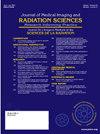Identifying Barriers to Low Completion Rates of Symptoms Screening via Electronic Patient-Reported Outcome Measures (ePROMs) among Patients Receiving Radiation Therapy Treatments at Stronach Regional Cancer Centre (SRCC)
IF 1.3
Q3 RADIOLOGY, NUCLEAR MEDICINE & MEDICAL IMAGING
Journal of Medical Imaging and Radiation Sciences
Pub Date : 2025-05-01
DOI:10.1016/j.jmir.2025.101938
引用次数: 0
Abstract
Purpose/Aim
Symptom screening, branded as Your Symptoms Matter (YSM), via Patient-Reported Outcome Measures (PROMs) is a vital component of cancer care. It is well documented in the literature that when completion rates for PROMs are low, it can lead to incomplete patient-reported data limiting healthcare providers' understanding of patient symptom burden. This can ultimately hinder effective and timely symptom management, access to resources crucial to providing personalized care and have negative impacts on quality of life. As per OH-CCO recommendation, patients are encouraged to complete PROMs surveys via online or at touchscreen kiosks at the Cancer Centres. Current completion rates via electronic PROMs (ePROMs) remain low at our department. Majority of patients rely on physical paper form – which imposes problems including waste of resources that are already available, increased administrative workload for staff as they have to transcribe results manually, as well as accuracy of the data can be compromised during manual data entry. Improvement of YSM completion rates is a strategic goal for our Cancer Centre to ensure compliance of best practice in providing patient-centered care. This project will analyze our current YSM completion rate via ePROMs and explore the major barriers of using ePROMs by patients in our centre.
Methods/Process
To understand our current YSM completion rates via ePROMs, we will be extracting PROMs completion data from the electronic patient record (MosaiQ) and find out the proportion of patients completing YSM utilizing ePROMs. To better understand and identify the root causes of low YSM completion rates via ePROMS, a survey outlining the major barriers of using ePROMs by patients from the literature, will be performed by both staff and patients. We will then further analyze these causes utilizing different diagnostics tools including a Fishbone diagram, 5-Why's as well as a Pareto to identify, analyze, and address the root causes of problems by providing clear data and insights. A driver diagram will also be created based on these findings, where change ideas will be developed and implemented in the next phase of the project.
Results or Benefits/Challenges
YSM completion rate via ePROMs for the radiation therapy department during April to June of 2024 was low, particularly, completion of YSM using kiosks was below 20 during the analyzed period. An anonymous staff survey was conducted among forty-five radiation therapists, as well as four oncology nurses to identify the top three causes that staff consider as main causes for low utilization of touchscreen computer kiosks. A total of seventeen completed surveys were collected in the end.
Conclusions/Impact
The three root causes contributed to low completion rate of YSM via ePROMs in our department include: “No one had explored other potential locations for the touchscreen computer”, “Staff may not understand the benefits and how easy it is to complete symptoms screening using ePROMs to complete YSM”, as well as “There was no continuous monitoring of updating workflow to include ePROMs”. The next phase of the project will involve implementation of a number of plan-do-study-act (PDSA) cycles implementing the identified change ideas and, evaluate YSM completion rates via ePROMs with the improvement efforts.
通过电子患者报告结果测量(ePROMs)确定在斯特罗纳克地区癌症中心(SRCC)接受放射治疗的患者中症状筛查完成率低的障碍
目的/目的通过患者报告结果测量(PROMs)进行的症状筛查,被称为“你的症状很重要”(YSM),是癌症治疗的重要组成部分。文献充分证明,当prom的完成率较低时,可能导致患者报告的数据不完整,从而限制了医疗保健提供者对患者症状负担的理解。这最终会阻碍有效和及时的症状管理,阻碍获得对提供个性化护理至关重要的资源,并对生活质量产生负面影响。根据OH-CCO的建议,鼓励患者通过在线或在癌症中心的触摸屏亭完成PROMs调查。目前通过电子prom (eprom)的完成率在我们部门仍然很低。大多数患者依赖纸质表格——这带来了一些问题,包括浪费已经可用的资源,增加工作人员的行政工作量,因为他们必须手动抄写结果,以及在手动数据输入过程中可能损害数据的准确性。提高YSM完成率是我们癌症中心的战略目标,以确保在提供以患者为中心的护理方面符合最佳实践。本项目将分析我们目前通过eprom的YSM完成率,并探讨我们中心患者使用eprom的主要障碍。为了了解我们目前通过eprom完成YSM的比率,我们将从电子病历(MosaiQ)中提取prom完成数据,并找出使用eprom完成YSM的患者比例。为了更好地理解和确定通过ePROMS进行YSM完成率低的根本原因,工作人员和患者将根据文献进行一项调查,概述患者使用ePROMS的主要障碍。然后,我们将利用不同的诊断工具进一步分析这些原因,包括鱼骨图、5-Why以及帕累托,通过提供清晰的数据和见解来识别、分析和解决问题的根本原因。还将根据这些发现创建一个驱动图,其中将开发并在项目的下一阶段实现变更想法。结果或受益/挑战2024年4 - 6月,放疗科通过eprom完成YSM的比例较低,特别是在分析期间,使用kiosk完成YSM的比例低于20。对45名放射治疗师和4名肿瘤科护士进行了一项匿名员工调查,以确定员工认为触摸屏电脑kiosk使用率低的三个主要原因。最后共收集了17份已完成的调查问卷。结论/影响我们科室通过eprom完成YSM的低完成率的三个根本原因是:“没有人探索过触摸屏电脑的其他潜在位置”,“员工可能不了解使用eprom完成YSM的好处和完成症状筛查是如何容易”,以及“没有持续监控更新工作流程以包含eprom”。该项目的下一阶段将涉及实施一系列计划-研究-行动(PDSA)周期,以实施已确定的变更想法,并通过eprom评估YSM完成率和改进工作。
本文章由计算机程序翻译,如有差异,请以英文原文为准。
求助全文
约1分钟内获得全文
求助全文
来源期刊

Journal of Medical Imaging and Radiation Sciences
RADIOLOGY, NUCLEAR MEDICINE & MEDICAL IMAGING-
CiteScore
2.30
自引率
11.10%
发文量
231
审稿时长
53 days
期刊介绍:
Journal of Medical Imaging and Radiation Sciences is the official peer-reviewed journal of the Canadian Association of Medical Radiation Technologists. This journal is published four times a year and is circulated to approximately 11,000 medical radiation technologists, libraries and radiology departments throughout Canada, the United States and overseas. The Journal publishes articles on recent research, new technology and techniques, professional practices, technologists viewpoints as well as relevant book reviews.
 求助内容:
求助内容: 应助结果提醒方式:
应助结果提醒方式:


